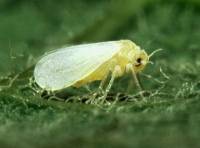This is an old revision of the document!
Table of Contents
Group 5
<html><font size=6 face=“Arial”>Sex ratio shift as an invasion strategy</font></html>
Wiki site of the practical exercise of the IX Southern-Summer School on Mathematical Biology.
Here you will find the exercise assignment and the group's products.
If you are a group member login to edit this page, create new pages from it, and upload files.
Introduction
Between 2000 and 2006, farmers and scientists watched an infection of Rickettsia bellii, a symbiotic bacteria, to skyrocket in Sweet-potato whiteflies, Bemisia tabaci. Martha Hunter of the University of Arizona in Tucson showed that the proportion of whiteflies infected with the bacterium in Arizona, New Mexico and California soared from 1% in 2000 to 97% in 2006.
The strategies that Rickettsia used to proliferate more quickly are very interesting. We know parasites typically spread in two ways: horizontally – in other words, within a generation – or vertically, from parent to offspring. Experiments ruled out horizontal transmissions of Rickettsia, and also show that the bacterium is passed from mother to offspring, whether or not the male population is also infected. Therefore, to increase the proliferation rate, Rickettsia helps female whiteflies not only to have more offspring, as well as it changes the sex-ratio of offspring towards female. But the presence of males should not be underestimated since they are important to generate female offspring because the whitefly species is haplodiploid, i.e., fertilized eggs generate diploid females and unfertilized eggs generate haploid males.

Himler et al. (2011) showed that female whiteflies (left imagem, from Wikipedia) infected by this bacterium produce twice more offspring and its progeny has biased sex-ratios (that is, ca. 3:7 male:female ratio). Uninfected female whiteflies produce unbiased offsprings, as expected by Fisher's principle, since unbalanced sex ratios strongly affect individual fitness.
What is suggested is an adaptive shift in sex allocation, which can occur when one of the sexes is more costly than the other. In many insects, including whiteflies, females are larger than males, hence they need more maternal resources to be produced. In this context, Rickettsia may provide products that are otherwise limiting for the production of ‘costly’ female offspring (for example, specific products that mediate fertilization, or limiting nutrients required in greater amounts by female than male progeny). This would be the reason that Rickettsia-infected whiteflies are able to produce more females.
In this project we are going to explore this mechanism, a symbiotic relation between bacteria and female whiteflies: Rickettsia provides females with more resources to produce more high-costing female progeny, while whiteflies producing more females benefits Rickettsia by increasing vertical transmission. But be careful, it’s mutual up to a point: if the sex ratio becomes too skewed, it could become detrimental to the whitefly parents. In a female-abundant scenario, parents that increase the rate of males in their progeny have fitness (Fisher's Principle, see references).
Assignment
Propose a mathematical model to investigate the strategy of sex-ratio shift in whiteflies caused by Rickettsia interference, the possible symbiotic mechanism discussed above. Explore the consequences of it to the bacteria invasion speed and the persistence of whiteflies.
Questions & Suggestions
- Can you come up with a quantification of the invasion speed in your model? How does it behave with the biasing of sex? Is there a ratio which provides the highest speed?
- What are the consequences of infection by Rickettsia to the persistence of whitefly species? Can high biased sex-ratios extinguish the population of whiteflies?
- Can this suggested mechanism explain an equilibrium at an unbalanced sex ratio in the population?
- Which parameters (and how) interfere in the population equilibrium sex ratio?
References
Anna G. Himler, Tetsuya Adachi-Hagimori, Jacqueline E. Bergen, Amaranta Kozuch, Suzanne E. Kelly, Bruce E. Tabashnik, Elad Chiel, Victoria E. Duckworth, Timothy J. Dennehy, Einat Zchori-Fein, Martha S. Hunter.Rapid Spread of a Bacterial Symbiont in an Invasive Whitefly Is Driven by Fitness Benefits and Female Bias. Science, 2011. Vol. 332, Issue 6026, pp. 254-256. https://science.sciencemag.org/content/332/6026/254.
A short article about sex-ratio shift in the light of evolution and natural selection: https://evolution.berkeley.edu/evolibrary/news/110401_whiteflies.
